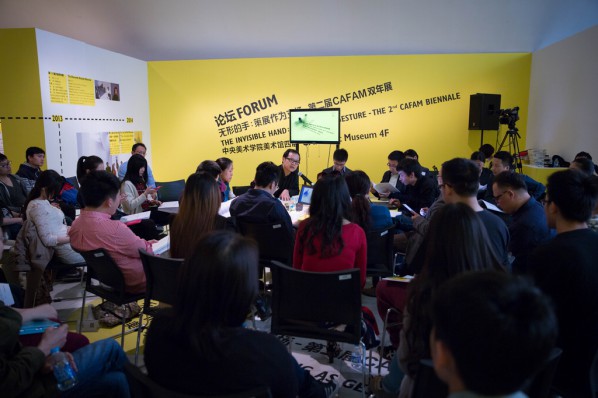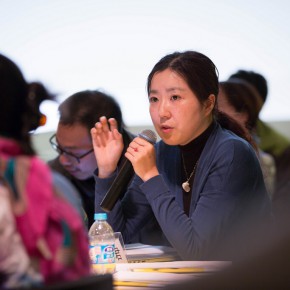
At 2:00 pm on April 12, 2014, the Second CAFAM Biennale Discussion “Curating Reason and the Critic” was held on the 4th floor exhibition hall of CAFA Art Museum. The host Wang Chunchen said, Chinese contemporary curating had a history of more than 30 years, curating was an important dimension and part of art history, he hoped through this discussion to promote the development of professional curating.
Critic Duan Jun, Fu Xiaodong, founder of Space Station, Hu Bin, Associate Professor of Guangzhou Academy of Fine Arts, Lu Mingjun, a lecturer from Art College of Sichuan University, Sheng Wei, Deputy Director of “Art” magazine, Lu Yinghua, Art Director of OCAT Shenzhen, Xia Kejun, Associate Professor of Renmin University of China, Wang Meng, a curator from the National Art Museum of China were invited to attend the discussion, where all the honored guests discussed the subject “curating reason and the critic”, according to their own experiences and thinking, they talked about how the curators worked, and what problems they faced.
Hu Bin: Historic Curating
Nearly 20 years of historic curating has been disruptive, the new art history and visual culture doesn’t focus on displaying important works any more, but starts to pay attention to the importance of literature, and also questions previous art history, at the same time as reflecting on the narrative structure of the exhibition. Therefore, Hu Bin put forward the following questions: Can curators gave objective historical clues, or do other people have the right to divide collections, although historic curating was the historical textual visualization, it didn’t reflect the independence and creative nature of the curators. If curating is as a form of creation, what is the difference between curators and artists’ work?
Lu Yinghua: Curating Tries to Make History Transparent
In her speech, Lu Yinghua focused on her recently planned exhibition OCAT Shenzhen which was entitled “From the Issue of Art to the Issue of Gesture: the Echo of the Socialism and Realism”. Lu Yinghua draws on lessons from the show in excavating items in archaeology, and numbered every present artist and event, which made the works and the literature present a non-interpreted ambiguous possibility. Lu hoped to make history transparent in the planning and reproduction of the viewing experience through this exhibition.
Fu Xiaodong: My Curating Practice
Fu Xiaodong talked about her 20 years of curating in detail, and her work focused on the creating skills of young artists, because she thought the young artists were the most active group, showing the changes of the times and new artistic phenomenon. Then she summarized her planning into three parts: “public field", “extreme individual”, and “participating space”.
Lu Mingjun: From “BizArt” to “MadeIn Company”
Lu Minjun initially briefed the audience on the establishment and the exhibition practices of Shanghai “BizArt” and the “MaidIn Company”, and through their experiences to present three aspects of reflection: from the other people’s domination to autonomy; temporary space, and curating and the critic; the systematic practice was within the art practice. He hoped that the exhibition practice returned to the relationships in contemporary China and the contemporary world, based on which we put forward our issues: curators had a consciousness of issue, instead of a tendency and attitude; the exhibition work served or proved the curating idea, rather than discussingthe idea.
Sheng Wei: The Contradiction between Art History and Geography
Sheng Wei said curators should have a globalized macroscopic vision, similar to productive behavior, rather than just combing through and summarizing art history.
Duan Jun: The Difference between the Art Critic and Curating
Duan Jun said the difference between curators and critics didn’t only lie in the activities of technology and practice, he thought curating was a kind of “more creative activity”. Don’t focus on updating curating practice and ideas, but emphasize the promotion and the presentation of different appearances of Chinese contemporary art.
Xia Kejun: Chinese Art Need Philosophy
Xia Kejun is a Doctor of Philosophy, and his discussion started from the perspective of philosophy. Xia put forward the concept of “virtual and thin”, it was a secret concept put forward by Duchamp in 1937 when he thought of the possibility between existing items and art, and Xia believed that it was the traditional Chinese literati’s virtual and light aesthetic concept, this aesthetic attitude of resonating spirit was dominated by the flow of virtual energy.
Wang Meng: Art Museum should break the Relationship between the Original Ecology of Art and the National Cultural Strategy
Wang Meng believed that in the current diverse curating era, the National Art Museum of China was faced with challenges, while taking CAFAM Future Exhibition as the field for new artistic phenomenon to breed and develop, CAFA Art Museum’s curating practice had strides in front of the nation.
In addition, the event also invited some students from the Department of Art History with sharp views against the Biennale to attend the discussion: Zhang Chen, Meng Yuan, Li Chao, and JiaYunbo, etc. They shared their thoughts of the Biennale, including the reflection of curating power, asking questions of the Biennale, etc.
At the end of the discussion, Wang Chunchen concluded: Curating was very important but it was also full of challenges and many problems; curating meant a kind of transformation of new thinking; wishing that curating was a mechanism to build a relationship between us and art, and opened the door to art curating.
Journalist: Ye Yuanfeng, Photo: Hu Zhiheng/CAFA ART INFO.
Translated by Chen Peihua and edited by Sue/CAFA ART INFO.



















































